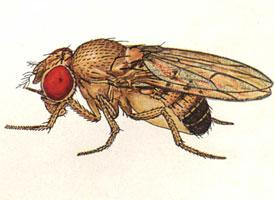
Poids et mesures
| Longueur | de 2 à 3 mm |
|---|
Description de l'animal
The fruit fly, scientifically known as Drosophila melanogaster, is a small, dipterous insect belonging to the family Drosophilidae. This species has been extensively studied and is renowned for its immense contribution to genetic research, earning it the status of a model organism in the fields of genetics, developmental biology, and neuroscience. D. melanogaster has a body length of about 2.5 to 3 mm, with females generally being slightly larger than males. The body of the fruit fly is segmented into three distinct parts: the head, thorax, and abdomen, with a pair of large, red compound eyes dominating the head.The thorax houses a pair of wings and three pairs of legs, each equipped with tiny claws and pads that enable the fly to cling to smooth surfaces. The wings are clear, with a characteristic pattern of veins that are used for species identification. The abdomen contains the reproductive organs, which are crucial for the species' prolific breeding. The coloration of Drosophila melanogaster ranges from yellow to brown, with a series of dark bands running across the abdomen.
Fruit flies have a relatively simple life cycle that can be completed in about 10 days at optimal temperatures (around 25°C), which makes them highly suitable for laboratory research. Their life cycle encompasses four distinct stages: egg, larva, pupa, and adult. Females lay their eggs in fermenting fruit or other decaying material, which provides an abundant food source for the emerging larvae. The larvae feed voraciously, going through three instars before pupating. During the pupal stage, the larva undergoes metamorphosis and emerges as a winged adult ready to reproduce, thus continuing the cycle.
Drosophila melanogaster is primarily known for its role in scientific research. The pioneering work of Thomas Hunt Morgan in the early 20th century utilized D. melanogaster to confirm the chromosome theory of inheritance and discovered the phenomenon of genetic linkage. The fruit fly's genetic makeup is relatively simple, with only four pairs of chromosomes, yet it shares a significant portion of its genes with humans, making it an invaluable tool for understanding human genetics and diseases.
One of the most notable features of Drosophila melanogaster is its use in the study of genetics and developmental biology. Its genome was fully sequenced in 2000, revealing about 14,000 genes on its four chromosomes. This has facilitated a deeper understanding of genetic processes such as gene regulation, mutation, recombination, and evolutionary biology. Moreover, the ease of maintaining and breeding fruit flies in large numbers, combined with their short generation time, allows for large-scale genetic screens that are not feasible with more complex organisms.
In summary, Drosophila melanogaster, the fruit fly, is not only a common visitor to our kitchens but also a powerhouse of genetic research. Its simple yet complex biology offers invaluable insights into the mechanisms of life, contributing significantly to our understanding of genetics, development, and disease.
Nouvelles photos d'animaux
Top 10 des animaux
- Dolphin gull (Leucophaeus scoresbii)
- Japanese macaque (Macaca fuscata)
- Stone loach (Barbatula barbatula)
- Greek tortoise (Testudo graeca)
- Russian tortoise (Testudo horsfieldii)
- Galápagos tortoise (Geochelone nigra complex)
- Diana monkey (Cercopithecus diana)
- Moustached guenon (Cercopithecus cephus)
- Common flying dragon (Draco volans)
- Galápagos penguin (Spheniscus mendiculus)